HERNIA INTERNATIONAL CAMPAIGN IN PUCALLPA (PERÚ)
1-12 August 2015
INTRODUCTION
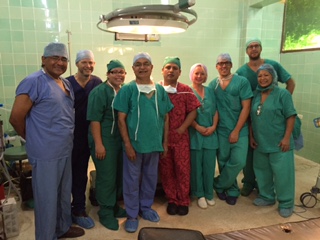
A new cooperation campaign took place last August in the city of Pucallpa (Perú). Pucallpa is situated by the Ucayali river in the region of the same name. It is a city of constant population growth, which actually has 250.000 inhabitants. Its main economic activity is fishing, agriculture and timber.
Since 1994 the Nacional Pucallpa Police manages and promotes (through its Health Department “Sanidad de la PNP” and Dr. David Tarazona, surgeon and chief of that body) a surgical campaign for persons without economic means and with difficulties in acceding Public Health. This risk population, chiefly made up by working age men, is a serious problem for society and family, since such hernia patients cannot carry out in a normal way any work or family activity given the problems this entails at a financial and social level. Since 1994 the yearly number of patients operated upon in that campaign has been between 40 and 60; still this year, with the help of Dr. Ameth Álvarez (general surgeon and captain of the PNP) the ambitious project was proposed of operating about 200 patients during the August 2015 campaign, given the great problem that hernia pathology was in Pucallpa society. In order to achieve that objective a perfect coordination was achieved between Dr. Álvarez, Dr. Tarazona, Dr. Juan Jaime Herrera (Head of Surgery in the Police Hospital in Lima) and the “Hernia International ONG” with the collaboration of “Cirujanos en Acción”. Thanks to the excellent disposition of all these and to the collaboration of professional doctors /anaesthesists and surgeons) of both ONGs it has been possible to carry out and bring to a successful end that hernioplastics campaign which ended on last August 12th after having operated upon more than 170 patients (many of them through more than one surgical intervention, which raises the figure to more than 200), Since 1994 when this selfless and ambitious surgical campaign began, more than 1300 patients without economic means have been operated upon for hernia pathologies.
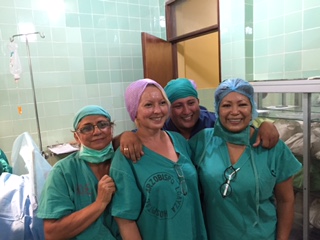
MATERIAL AND METHODS
Objective: Operating upon 170 patients without economic resources and with a hernia pathology in the Pucallpa region, thus achieving the recommended level (less than 2%) and making use of the surgical techniques used in higher economic milieus (hernioplatics with placement of prothesis) so as to bring down the number of repeated cases in such a pathology.
Place: The surgical campaign has always taken place in the SANATORIO DE LA POLICÍA NACIONAL in Pucallpa where we had at our disposal the following facilities:
– Surgical room with two beds
– Room for minor operations with two beds
– Room for sterilization
– Room for examination of patients
– Several rooms for recovery with beds where 16 patients could be accommodated at a time who usually could leave the same day of the operation if there were no further complications.
Staff: The health staff has been the FUNDAMENTAL element in this campaign so that it would not have been possible without it. The commitment of nurses and helpers has been excellent. The people who have worked in the campaign have been the following:
– Nurses from the Police Health Centre
– Clarks, helpers, cleaners and and the rest of persons in the said centre.
– Surgeons: Dr. Tarazona, Dr. Álvarez, Dr. Jaime Herrera, Dr. Sambu, Dr. Verdes, Dr. Abellán.
– Anaesthetists: Dra. Renata, Dr. Paul Wilkins
– Students from the “Universidad de Medicina” in Pucallpa.
Anaesthetic and surgical material: The necessary material for the surgical campaign has been chiefly provided in a selfless way by the anaesthetists and surgeons who have taken part in the campaign as it is given in detail lower down. The Police Health Centre, thanks to some local institutions, has also contributed with some material (serum, nylon and polyester sutures, sterile gloves, surgical gowns, surgical llinen…)
Material provided by medical staff:
Dr. Shambu: Mosquito net prosthesis supplied by Hernia International for surgical operations. The given material has been sufficient for all the operations.
Dr. Abellán/Dr. Verdes: Endotraqueal tubes (6), epidural syringes (3), spinal needles (8), subcutaneal, intramuscular and “de carga”. Local anaesthetic (mepivacaina) (25 un). Gentamicina (10 un).
Polipropileno meshes (30), boxes with gloves of various sizes (4), box with caps (100), 2 boxes of masks (100), 2 boxes of exploration gloves (200).
Sutures: polipropileno 2/0 (2 boxes: 72 un), polipropileno 3/0 (2 boxes: 72 un),silk 3/0 (100 un), Vicryl 2/0 (2 boxes: 72 un), lazo Maxon 0 (21 un), polisorb 3/0 (8 un), polisorb 2/0 (7 un). Silk ligature (50 un).
Surgical washing gel, hidrogel, clorhexidina, tegaderm gel (9 un), Acuacell silver (8 un), Surgicel hemostatic (4 un), Espongostan (1 un.), Mepitel (2 un), Steri-trip (25 un), Iruxol. Furacin, Silvederma…
Drainages: 7 drainages of the aspirating type with their pouch, Foley catheter (8 un), endotraqueal catheter (15 un), Penrose type capillarity catheters (5).
Electric scalpel (8 un). Long scalpel terminals (4 un), cold scalpel blades (100).
Sterile gauzes and compresses More than 200 un.
Surgical staples and staple removers (10 un)
Elastic bandage, crepés and other material
Dra. Renata/Dr. Paul Wilkins: 2 ambús (adult and child), 4 philters, 2 endotraqueal guides, 15 endotraqueal tubes, 8 Guedel cannulas, 15 adult and pediatric larynx masks (3 un), 75 vein cannulas with peripheral access. – 2 pediatric circuits for the respirator, endotraqueal pediatric tubes (4 un), lubricating for tube, anesthetic pediatric mask Oxygen therapy systems.
Intubation wings (laryngoscopies). (3 un.)
Metamizol ampoules (100 un)
Dexametasona 4 mg ampoules (100 un)
Buscapina (100 ampoules)
Ropivacaina for local anaesthetics (150 ampoules)
Cefazolina 1 gram (100 un)
Epidural syringes (100 units), epidura charging needles, subcutaneous and intramuscular needles and diverse sizes syringes (more than 200 units).
Sterile gloves (100 un)
Surgical dresses (10 trousers and 10 shirts)
Sundry material (gauzes, antiseptic, sterile pads—)
NOTE:
1. All the remaining material from the medical team remained in the health centre at the disposal of the health staff in Pucallpa.
2. It was necessary to buy some anaesthetic material locally (Spinal needles and anaesthetic medicines for sedation) whose cost in its entirety was supplied by the team of anaesthetists.
Criteria for refusal of patients: Those patients with VIH and those with multiple basic pathology (advanced cardiopathy, breathing problems, alteration in coagulation…). ULTS
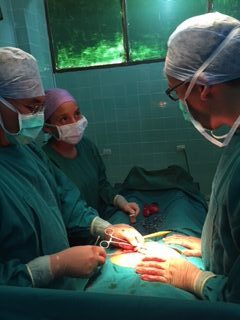
RESULTS:
1. Teaching
Part of the medical team (Dr. Israel Abellán / Dr. Jorge Verdes) gave a talk with the title “Surgical handling of the complex eventration” in the Casa de la Cultura of Pucalpa addressed to medical students of the region and to the whole medical staff interested in the topic. At the end of the session there was an interesting time of questions and debate. 5
Daily during the surgical activity there were activities for the formation of medical students of all courses. Given the high number of patients and the need to work simultaneously on 4 surgical tables the usual team for each intervention was formed by a surgeon and a medical student. The satisfaction on the part of the students was total as this was a very practical and very unusual practice during formation.
2. Clinical results
During the health campaign 170 patients of hernia pathology were operated upon, some of which needed several interventions for bilateral hernias. The type of hernia/eventration treated was not similar to the one within us, as they were usually hernias of a great size of many years standing, which required a more complex surgical prodcedure.
The type of intervention carried out was similar to the usual one with us, placing the polipropileno prosthesis or the mosquito net mesh according to availability.
The interventions were carried out in equal number by all the members of the medical team, with 1 anaesthetist and 2 surgeons.
All patients beyond 60 years with some complication or with large size hernias were given ATB prophylactic treatment.
Number of patients treated: 170
Number of procedures: 220
Number of adults: 162
Number of children treated: 8
Number of daily procedures: 14-17 procedures.
BY PATHOLOGIES
Inguinal region hernia: 142
Umbilical hernia: 30
Epigastrical hernia: 20
Middle type eventration: 20
Spiegel hernia: 2
Lipomae/soft parts hurts: 3
Other: 3
Total: 220 procedures
Type of anaesthesis used: SPINAL 105 PATIENTS / LOCAL AND SEDATION 60 PATIENTS / GENERAL: 5 patients.
COMPLICATIONS
Heavy: there was no acute complication during the first 24 hours after the operation.
Recurring: Up till today that we are in touch with Dr. Ameth to follow the evolution of our patients we have had the following complications:
Surgical seroma wound: 2 patients
Surgical hematoma wound: 1 patient. He has not needed surgery and improves with conservative treatement.
Surgical wound infection: 4 patients.
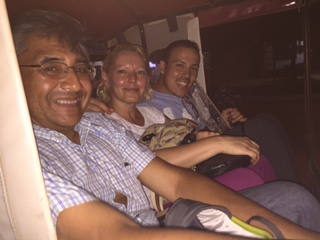
CONCLUSIONS
The conclusions after finishing our Hernia International campaign 2015 cannot be more positive. When we arrived at Pucallpa we found that Dr. Ameth Álvarez had done great work in the study and selection of patients (all of them had gone through pre-operation preparation with serology and hemogram and pathological exploration, and had been uniformly distributed by days according to the complexity of each procedure). The cooperation on the part of the healthstaff at Pucallpa was excellent, from workers, nurses, cleaners to medical students… All of them were at our disposal and worked intensely in order to achieve the daily objectives. At a personal level, dealing with the patients and the people of Pucallpa has been an intense and unforgettable experience, and this is doubtless what has given its real justification to the whole work on those days.
On the last day of our work (August 12th) we had a thrilling closing function where ALL the patients and relatives how had taken part in the surgical campaign were invited, together with the Pucallpa health staff and the medical team.
Thanks to Dr. Ameth, to the health staff and to the patients and the people of Pucallpa this health campaign has been a success with respect with the intended objectives. There is no doubt that the organization, the selfless work and the sharing of such staff will be assured in future campaigns.
ISRAEL ABELLAN
Addendum (Paul Wilkins)
Educational Activities
Besides on the go teaching of the medical students, Dr Israel Abellàn and Dr Jorge Verdes also gave a talk at La Casa de Cultura de Pucallpa on the subject of the ‘Surgical Management of Large and Complex Incisional Hernias’. This was well received by the medical students and other interested health personnel present.
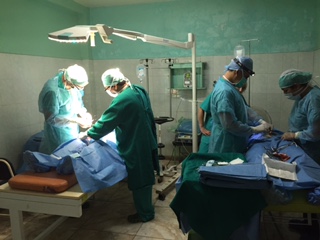
Social and Cultural Aspects
The working day began at 8 a.m and usually finished about 2.30 p.m. This left time free to explore the local markets and the nearby Lake Yarinacocha, where the opportunity was also taken to visit a village of the indigenous people. We also had one day off and took an excursion by minibus to a nearby waterfall where we enjoyed a pleaseant swim with the locals. Our after work activities were advised and often accompanied by Dr Àlvarez and his lovely wife who took great pains to ensure our stay was as enjoyable and interesting as possible.
All members of the team got on very well socially and professionally and we hope to meet and perhaps work together again one day.
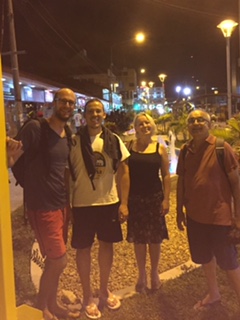
Conclusions
All in all, I can say that this was a successful mission in every way. 220 procedures were successfully completed with minimal complications on 170 patients many of whom showed their gratitude by attending the moving closing ceremony on the last day of the campaign.
The medical students whose help we were very grateful for were very appreciative of the teaching and patience shown to them by the surgeons and in particular Drs Verdes and Abellàn. We were moved to receive some small gifts from them to show their gratitude.
The preparation of patients, staff and facilities was excellent and the hard work of Dr Àlvarez must be noted again in this regard. If anything could be improved, it would be that there should be direct communication by email beforehand with the person co-ordinating the campaign locally, in this case Dr Àlvarez with regard to case mix and materièl available locally. This, together with communication between surgeons and anaesthetists as to the most suitable type of anaesthetic, would ensure that all the necessary and the minimum of unnecessary supplies could be brought by the team.
It was remarkable to me how well and enthusiastically everybody, whether nurses, students, ancillary staff or doctors, worked together towards a common goal. Conditions and demands were different and challenging for all in their individual ways and yet everybody worked harmoniously to achieve a successful mission.
The stoicism, patience and gratitude of the patients was salutary and I feel humbled and privileged to have been able to help these people.
Finally, I must thank my fellow team members for the sacrifice of their time and resources, their patience and skills, which made all this possible. I could not have wished for better colleagues.
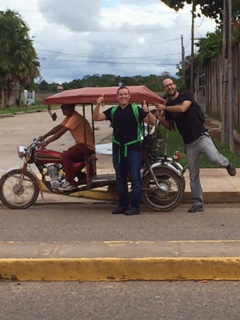
Gracias amigos
PAUL WILKINS
Australia. Sept 2015

